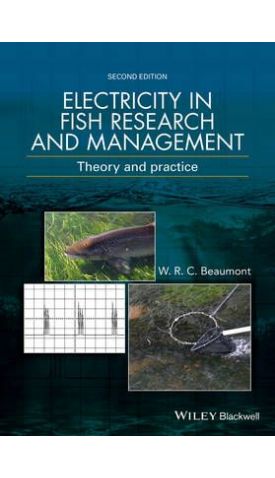אנו משתמשים ב-Cookies כדי לשפר את החוויה שלך. כדי לקיים ההנחיה החדשה של e-Privacy, עלינו לבקש את הסכמתך להגדיר את ה-Cookies. קבלת מידע נוסף.
551.00 ₪
Electricity in Fish Research and Management - Theory and Practice, 2e
551.00 ₪
ISBN13
9781118935583
יצא לאור ב
New York
מהדורה
2nd Edition
זמן אספקה
21 ימי עסקים
עמודים
192
פורמט
Hardback
תאריך יציאה לאור
15 באפר׳ 2016
Electricity in Fish Research and Management, 2nd Edition provides a comprehensive discussion of the uses of both electricity and electrical principles in fishery management and research.
Electricity in Fish Research and Management, 2nd Edition provides a comprehensive discussion of the uses of both electricity and electrical principles in fishery management and research. It covers electric fishing (including theory, equipment, data analysis and practical factors affecting efficiency), fish barriers, fish counters and fish welfare issues. The book concentrates on Electric Fishing (or Electrofishing); an internationally accepted and widely used procedure for sampling fish. Over the past 50 years electric fishing has become a standard method for fishery studies and management e.g. establishing population densities and abundance. However, due to the potential hazards of the method (both to operators and fish) there is a continuing need to develop and promote best practice guidelines. The author has studied fish ecology for 40 years and understands the need for information that reaches out to all levels of understanding in the field. Previous books on this subject have either been collections of scientific papers and/or technical reports or very simple instruction manuals. In this book theory and practice is explained using non-technical language and simple equations.
It brings depth as well as breadth in both information and principles behind the methods and should be an invaluable tool to both fisheries managers and researchers. Although the book is aimed at undergraduates, the clear explanation of the factors means that the book is suitable for all levels of practitioners.
| מהדורה | 2nd Edition |
|---|---|
| עמודים | 192 |
| פורמט | Hardback |
| ISBN10 | 1118935586 |
| יצא לאור ב | New York |
| תאריך יציאה לאור | 15 באפר׳ 2016 |
| תוכן עניינים | Acknowledgements, viii 1 Introduction, 1 2 The history of electricity in fish research, 3 3 Electric fishing, 7 3.1 Health and safety, 13 3.1.1 Electric shock, 14 3.1.2 Drowning, 16 3.1.3 Tripping or falling, 16 3.1.4 Trauma, 16 3.2 General issues, 16 4 Electrical terms, 17 4.1 Circuit, 19 4.2 Voltage, 19 4.2.1 Voltage gradient, 22 4.3 Voltage waveforms, 26 4.3.1 Alternating current, 27 4.3.2 Direct current, 28 4.3.3 Pulsed direct current, 30 4.3.3.1 Pulse frequency, 35 4.3.3.2 Pulse width, 38 4.4 Electrical current, 41 4.5 Power, 42 4.5.1 Power factor, 44 4.6 Resistance and resistivity, 44 4.6.1 Electrode resistance, 47 4.6.2 Kirchoff s Law, 49 4.7 Conductance and conductivity, 51 4.7.1 High ]conductivity water, 52 4.7.2 Low ]conductivity water, 52 4.8 Fish conductivity, 53 4.8.1 Water fish conductivity ratio, 55 4.8.1.1 Graphic depiction, 57 4.8.1.2 Circuit theory, 57 4.8.1.3 Power Transfer Theory (PTT), 58 5 Electric fishing equipment, 63 5.1 Generators, 64 5.1.1 Use of multiple generators and control boxes, 65 5.2 Control boxes, 66 5.2.1 Generator ]based control boxes, 67 5.2.1.1 Control boxes with no facility to control output, 68 5.2.1.2 Control boxes with limited ability to control output, 68 5.2.1.3 Control boxes where many parameters of the output can be controlled, 70 5.2.2 Battery ]powered control boxes, 71 5.3 Electrodes, 72 5.3.1 Anodes, 73 5.3.1.1 Anode shape, 75 5.3.1.2 Anode size, 77 5.3.1.3 Twin and multiple anodes, 79 5.3.1.4 Anode ergonomics, 81 5.3.2 Pre ]positioned area samplers (PPAS), 82 5.3.3 Point abundance sampling using electricity (PASE), 83 5.3.4 Electric nets, 84 5.3.5 Cathodes, 85 5.4 Hand nets, 87 5.4.1 Banner nets, 90 5.5 Stop nets, 90 5.6 Protective and safety equipment, 92 5.6.1 Waders, 92 5.6.2 Gloves, 92 5.6.3 Other protective clothing, 93 5.6.4 Lifejackets, 93 6 Practical factors affecting electric fishing efficiency, 94 6.1 Manpower requirements, 94 6.2 Streambed: conductivity and substrate type, 95 6.3 Weather, 96 6.4 Water temperature, 96 6.5 Fish size, 97 6.6 Fish species, 98 6.7 Fish numbers, 99 6.8 Water clarity, 100 6.9 Site length, 100 6.10 Water depth, 101 6.11 Site width, 101 6.12 Time of day, 102 7 Electric fishing working techniques, 103 7.1 Operator skill and fishing and processing methods, 103 7.2 Fishing using wading, 106 7.2.1 Wading fishing using boats, 108 7.3 Fishing from boats, 110 7.3.1 Boom ]boats, 111 8 Electric fishing best practice, 116 9 Fish population assessment methods, 122 9.1 Estimating relative abundance, 124 9.2 Estimating actual population size, 126 9.2.1 Capture mark recapture estimates (CMRs), 127 9.2.2 Catch depletion estimates, 128 10 Fish barriers, 132 11 Fish counters, 138 12 Electroanaesthesia, 142 13 Fish welfare, 145 13.1 Fish handling, 146 13.2 Stress, 146 13.3 Anaesthesia, 148 13.4 Fish density in holding bins, 151 13.5 Oxygen and carbon dioxide, 153 13.6 Ammonia, 154 13.7 Temperature, 155 13.8 Osmotic balance, 155 13.9 Sensitive or robust fish, 155 13.10 Fish eggs, 156 13.11 Bio ]security, 156 14 Record keeping required, 158 15 Summary, 159 Glossary, 161 References, 166 |
| זמן אספקה | 21 ימי עסקים |



Login and Registration Form